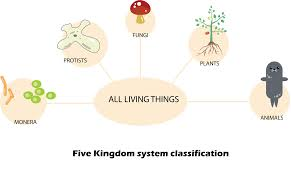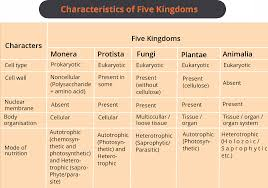Ever Wondered How Scientists Organise All Living Things?
When you look around, you see an incredible variety of living beings—from tiny bacteria in the soil to huge trees in forests and majestic animals roaming the planet. Scientists have always sought a systematic way to study this diversity, and that’s where the five kingdom classification comes into play.
In this guide, you’ll learn how the five kingdom classification was proposed by R.H. Whittaker, explore its key features, compare it briefly with the 7 kingdom classification and three kingdom classification, and see why it remains vital for understanding life on Earth. We will also show a five kingdom classification chart and provide five kingdom classification with examples to help you grasp the concept better. Let’s begin!
What is Classification and Why does it Matter?
Classification is the biological method of grouping and organising living organisms based on shared characteristics. It helps us:
Simplify the study of millions of species.
Understand how different organisms relate to one another.
Trace the evolutionary paths and relationships (phylogeny) among various groups.
Communicate clearly about organisms with standard scientific names and categories.
Earlier, scientists relied on simpler systems, like the three kingdom classification (e.g., Animalia, Plantae, Protista) or even a basic two-kingdom system (just plants and animals). However, these did not capture the full diversity of life forms adequately.
Who Proposed the Five Kingdom Classification?
The five kingdom classification was proposed by Robert H. Whittaker in 1969. He created this system to address the shortcomings of older classification methods, ensuring organisms were placed in categories reflecting:
Cellular structure (prokaryotic or eukaryotic)
Body organisation (unicellular or multicellular)
Nutritional modes (autotrophic or heterotrophic)
Reproduction (sexual or asexual)
Phylogenetic relationships (evolutionary history)
His system divides all known organisms into five kingdoms:
Monera
Protista
Fungi
Plantae
Animalia

Five Kingdom Classification Chart
A typical five kingdom classification chart groups organisms as follows:
Monera Kingdom
All prokaryotic organisms (like bacteria).
Kingdom Protista
Eukaryotic, mostly unicellular organisms (like amoeba, paramecium).
Kingdom Fungi
Eukaryotic, mostly multicellular (except yeast), cell walls contain chitin (like mushrooms, moulds).
Kingdom Plantae
Eukaryotic, multicellular, autotrophic with cell walls made of cellulose (like mosses, ferns, flowering plants).
Kingdom Animalia
Eukaryotic, multicellular, heterotrophic with no cell walls (like sponges, insects, fishes, mammals).

This arrangement helps us understand each group’s distinguishing features. It also contrasts neatly with the 7 kingdom classification and some variations of the three kingdom classification.
A Closer Look at the Five Kingdoms
1. Monera Kingdom
Key Features:
Prokaryotic (no well-defined nucleus).
Mostly unicellular.
Cell walls often made of peptidoglycan.
Includes bacteria and cyanobacteria.
Nutrition: Can be autotrophic (photosynthetic like cyanobacteria, or chemosynthetic) or heterotrophic (parasitic or saprophytic).
Unique Fact: Some bacteria thrive in extreme conditions (e.g., hot springs, salt lakes), showcasing the remarkable adaptability of the monera kingdom.
2. Kingdom Protista
Key Features:
Eukaryotic but mostly unicellular.
May have cilia, flagella, or pseudopodia for movement.
Sexual reproduction typically involves cell fusion and zygote formation.
Major Groups:
Chrysophytes (diatoms, golden algae)
Dinoflagellates (photosynthetic, primarily marine)
Euglenoids (freshwater, no rigid cell wall, have pellicle)
Slime moulds (saprophytic)
Protozoans (amoeba, paramecium, mostly heterotrophic)
Unique Fact: Protists are a very diverse group; some can photosynthesise, while others devour their food just like animals do!
3. Kingdom Fungi
Key Features:
Eukaryotic, mostly multicellular (except yeast).
Cell walls are made of chitin.
Body is organised into thread-like hyphae; a network of hyphae is called mycelium.
Can be coenocytic (no cross-walls) or septate (with cross-walls).
Mode of Nutrition:
Primarily saprophytic (feeding on dead organic matter).
Some are parasitic, while others form symbiotic relationships (e.g., lichens with algae, mycorrhiza with plant roots).
Unique Fact: Fungi play an enormous role in decomposition and nutrient recycling.
Also read about Fungi
4. Kingdom Plantae
Key Features:
Eukaryotic, multicellular, cell walls of cellulose.
Mostly autotrophic (using chlorophyll for photosynthesis).
Show alternation of generations (haploid gametophyte and diploid sporophyte stages).
Examples:
Algae, bryophytes (mosses), pteridophytes (ferns), gymnosperms (pine), angiosperms (flowering plants).
Unique Fact: Some plants like the Venus flytrap can digest insects, showcasing that not all plants rely solely on photosynthesis.
5. Kingdom Animalia
Key Features:
Eukaryotic, multicellular, no cell walls.
Heterotrophic (rely on other organisms for food).
Usually capable of movement at some life stage.
Reproduction largely sexual.
Examples:
From simple sponges to complex mammals like humans.
Unique Fact: The animal kingdom is incredibly diverse, ranging from microscopic organisms to gigantic whales.
Five Kingdom Classification with Examples
Monera Kingdom: Bacteria such as Escherichia coli and Streptococcus
Kingdom Protista: Amoeba, Euglena, Paramecium
Kingdom Fungi: Yeast, Bread Mould (Rhizopus), Mushroom
Kingdom Plantae: Roses, Sunflowers, Mango Trees
Kingdom Animalia: Earthworms, Frogs, Elephants, Humans
By exploring the five kingdom classification with examples, it becomes easier to see the unique traits that set each group apart.
Comparisons with Other Classification Systems
Three Kingdom Classification: An older system that grouped some eukaryotes together in Protista and separated plants and animals. It lacked clarity on prokaryotic organisms, which are now placed in the monera kingdom.
7 Kingdom Classification: A more recent approach expands upon Whittaker’s ideas by further splitting certain groups, often separating prokaryotes into Archaea and Bacteria, and splitting Protista into multiple lineages. It recognises the vast diversity among organisms that were once lumped together.
Despite these updates, Whittaker’s five kingdom classification was proposed by him to revolutionise our understanding of life, and it still serves as a foundational framework in biology classes worldwide.
Unique Insights Beyond the Five Kingdoms
Viruses: They do not fit neatly into any kingdom because they are acellular, requiring a host to reproduce.
Lichens: Not a single organism but a symbiosis between fungi and algae (or cyanobacteria).
Horizontal Gene Transfer: Bacteria in the monera kingdom can exchange genes in ways that challenge traditional lineage-based classification.
These fascinating examples remind us that while classification systems are helpful, biology is often more complicated than any single arrangement can capture!
Fun Interactive Quiz
Which kingdom contains prokaryotic organisms?
A. Fungi
B. Protista
C. Monera
D. Plantae
Which kingdom’s cell walls are made of chitin?
A. Animalia
B. Fungi
C. Plantae
D. Protista
Which system was the five kingdom classification proposed by?
A. Carl Linnaeus
B. Ernst Mayr
C. Carl Woese
D. R.H. Whittaker
In which kingdom would you place a unicellular eukaryote with a pellicle?
A. Protista
B. Fungi
C. Plantae
D. Animalia
Which classification system separates organisms into prokaryotes and eukaryotes but does not address archaea specifically?
A. Five kingdom classification
B. 7 kingdom classification
C. Three domain system
D. Two kingdom classification
Check Your Answers:
C – Monera
B – Fungi
D – R.H. Whittaker
A – Protista
A – Five kingdom classification
Fun Task: Build Your Own Classification Tree
Objective: Explore your surroundings—garden, terrace, or even your kitchen. List 5 different living organisms (bacteria, a mushroom, a flower, an insect, etc.). Try to determine which kingdom each belongs to.
Hint: Use features like cell structure (if known), presence or absence of cell walls, and mode of nutrition to guide you.
Share & Discuss: Bring your list to a biology discussion group (or your Vedantu live class). Compare your observations to see how classification works for everyday creatures around you!


FAQs on Mastering the Five Kingdom Classification
1. What is the five kingdom classification system?
The five kingdom classification is a system proposed by biologist R.H. Whittaker in 1969. It organises all living organisms into five main groups, or kingdoms, based on key characteristics like cell structure, how they get nutrients, and body organisation.
2. Who proposed the five kingdom system of classification?
The five kingdom system of classification was proposed by the American biologist Robert H. Whittaker in 1969. His model was a significant improvement over the older two-kingdom system of just plants and animals.
3. What are the five kingdoms proposed by Whittaker?
The five kingdoms of life according to Whittaker's classification are:
- Monera: Includes all prokaryotic organisms like bacteria.
- Protista: Contains unicellular eukaryotic organisms like Amoeba.
- Fungi: Includes organisms like mushrooms and yeast, which are heterotrophic and have cell walls made of chitin.
- Plantae: Contains all multicellular, photosynthetic plants.
- Animalia: Includes all multicellular animals that ingest their food.
4. What is the main difference between Kingdom Monera and Kingdom Protista?
The most fundamental difference is their cell structure. Organisms in Kingdom Monera are prokaryotic, meaning their cells lack a true nucleus and other membrane-bound organelles. In contrast, organisms in Kingdom Protista are eukaryotic, possessing a well-defined nucleus and organelles.
5. Can you give an example of an organism from each of the five kingdoms?
Certainly! Here are some common examples:
- Monera: E. coli (a bacterium).
- Protista: Amoeba or Paramecium.
- Fungi: Mushroom or bread mould.
- Plantae: A rose plant or a mango tree.
- Animalia: An earthworm, a frog, or a human.
6. What is the main role of Kingdom Fungi in an ecosystem?
The primary role of fungi is to act as nature's decomposers. Most fungi are saprophytic, meaning they break down dead organic matter, like fallen leaves and dead animals. This process is crucial for recycling nutrients back into the soil, making them available for plants to use.
7. What were the main criteria R.H. Whittaker used for his classification system?
Whittaker based his five-kingdom system on several key characteristics to create a more natural and logical grouping. The main criteria were:
- Cell Structure: Whether the cells were prokaryotic or eukaryotic.
- Body Organisation: Whether the organism was unicellular or multicellular.
- Mode of Nutrition: How the organism obtains food (e.g., autotrophic, heterotrophic, saprophytic).
- Reproduction: The methods of reproduction.
- Phylogenetic Relationships: The evolutionary history and relationships between organisms.
8. Why are viruses, viroids, and lichens not included in the five kingdom classification?
These are not placed in any of the five kingdoms because they don't fit the classification criteria. Viruses and viroids are not true living organisms because they are acellular and cannot replicate without a host cell. Lichens are not a single organism but a symbiotic association between a fungus and an alga (or cyanobacterium).
9. How is the five kingdom classification an improvement on the older two-kingdom system?
The old two-kingdom system simply classified everything as either a Plant or an Animal. This created a lot of confusion, as it couldn't properly place organisms like bacteria (which are prokaryotic), fungi (which don't photosynthesise), or unicellular organisms like Amoeba. Whittaker's system solved this by creating separate kingdoms for these distinct life forms, reflecting their true biological differences.
10. If the five-kingdom system is so useful, why do some scientists now use a three-domain or seven-kingdom system?
Science is always evolving. While the five-kingdom system is excellent for foundational understanding, later genetic research revealed that life is divided into three major evolutionary lines called domains: Archaea, Bacteria, and Eukarya. This three-domain system, proposed by Carl Woese, is considered more accurate from an evolutionary standpoint. The seven-kingdom models are further refinements, often splitting Protista and Monera to better represent this diversity. However, the five-kingdom system remains a vital and widely taught framework.










